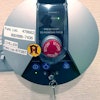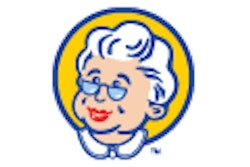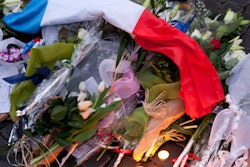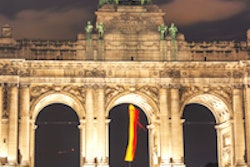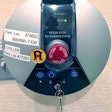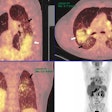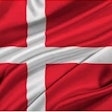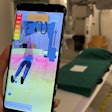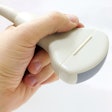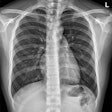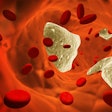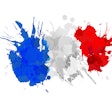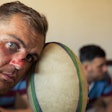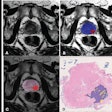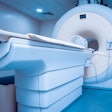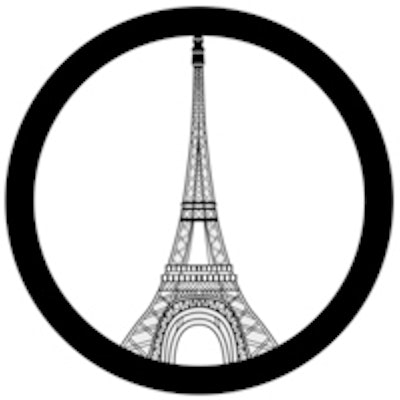
As the senior radiologist on call at Saint-Antoine Hospital in Paris on the night of 13 November, Dr. Catherine Phan was working her usual shift in the emergency room and the radiology department when she learned on the Internet a little before 10 p.m. there were gunshots in a café near the hospital.
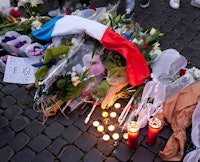 French flag and flowers for the Paris attacks.
French flag and flowers for the Paris attacks.The emergency room informed her the hospital would be receiving the injured, first from La Belle Equipe restaurant and then from the Bataclan theater. Just 10 minutes later, the injured started to arrive. In her 15 years as a radiologist, nothing had prepared her for what she was about to deal with.
"I had imaged two or three gunshot victims over my career, but this was off the scale. The patients came in a steady flow, most with severe blast and gunshot injuries. Most of the patients were very quiet, clearly in shock and great distress, many already hooked up to drips for blood transfusions," Phan told AuntMinnieEurope.com in an interview.
Beyond the call of duty
In such an event, the hospital is supposed to adhere to the "plan blanc" ("white plan"), which consists of a list of key workers living near the hospital who should be contacted in a large-scale emergency. Phan pays tribute to technicians and radiologists in her department, as well as the medical teams of her hospital, who went above and beyond the call of duty.
Phan and the resident on call were joined by two other radiologists. Seven more technicians arrived voluntarily to join the three on-call technicians, without even waiting to be asked. They had heard about the attacks and bravely made their way to the hospital across the city without knowing where and when another attack might take place. In total, the emergency imaging team included four radiologists and 10 technicians.
 Members of Saint-Antoine's imaging team who worked on 13 and 14 November. Dr. Catherine Phan is shown third from the left.
Members of Saint-Antoine's imaging team who worked on 13 and 14 November. Dr. Catherine Phan is shown third from the left.Once at Saint-Antoine, the technicians spread themselves between plain x-ray and CT, and they worked across the radiology department, the emergency operating room, orthopedic and visceral surgeries, and intensive care. Most of the attacks occurred in the 10th and 11th districts, and this meant that in total the hospital received around 50 patients, all of whom underwent x-ray, CT, or both.
"Several were too severely hurt and unstable to undergo imaging, so they went straight to the operating room. We decided to open the second CT scanner, and no imaging was delayed," Phan noted. "People who would ordinarily have come to A&E [accident and emergency unit] with relatively minor problems stayed away, which meant that we could concentrate on the attack patients."
Phan and others point to the excellent triage in place by the emergency medical service, Service d'Aide Médicale d'Urgence (SAMU), at the sites of attack. This enabled patients to be directed to the most appropriate hospitals. Patients with head wounds were sent to the Pitié-Salpêtrière Hospital, a renowned neuroradiology and neurosurgery facility. Other patients went to the European Hospital in the 15th district and Saint-Louis Hospital in the 10th district. It was unclear whether the coordinated attacks in Paris were over, and so Bicêtre Hospital was deliberately kept free in case its emergency department was needed.
Type of injuries faced
The emergency department at Saint-Antoine predominantly took patients with lesions to the chest, abdomen, and bone. In stable patients, CT was used to check for vascular injuries, entry and exit wounds, and mechanism of the gunshot and the related injuries.
Phan and her colleagues diagnosed hemothorax and pneumothorax in the chest, gastrointestinal perforation, hemoperitoneum, and kidney damage. Serious bone fractures that would probably lead to permanent impairment also were numerous. The CT and x-ray machines were used nonstop for five hours, only pausing in the early hours of Saturday once the last admission had been treated. A slowdown in the PACS at one point in the night due to systems updates did not cause a real problem.
"There were no delays. All the emergency imaging was treated within minutes, and images could be read on PACS if necessary. Less severe injuries were imaged within 30 minutes," Phan said. "I'm happy to report that all patients admitted to our hospital survived. Around 25 are still here being followed up."
Aside from the emergency protocol of the "white plan," the authorities have asked themselves what training would help hospitals cope in such situations.
"I don't think any amount of training could ever prepare you for something like this, as each attack is different, generating a varied set of problems, and requiring different organization," she commented.
Patients were put first, and although it was a traumatic night, the events revealed the moral fiber of all hospital staff who spontaneously rallied to help, despite the personal danger in getting to hospitals and the fact that they weren't obliged to come, Phan added.
Need for counseling?
Dr. Yves Menu, a member of the board of directors at Saint-Antoine and former ECR president, lauds the exemplary and courageous behavior of not just staff but also of patients who, aware of the gravity of the situation, put other more seriously injured people first.
 Dr. Yves Menu returned to Paris from a conference in Italy when he heard the news. Image courtesy of the European Society of Radiology (ESR).
Dr. Yves Menu returned to Paris from a conference in Italy when he heard the news. Image courtesy of the European Society of Radiology (ESR).Menu was attending a conference in Italy when a call came through about the attacks, but he cut short his trip and returned to Paris on that Saturday, keen to do what he could to help. He recalls the quietness of the hospital when he arrived, and the shock of his younger colleagues. Staff are still traumatized, and one junior colleague has spoken about difficulties sleeping at night, he said.
"The events were particularly distressing, because so many young people were injured and killed. Patients don't want to talk about it yet, but colleagues in psychology believe that counseling may be needed at different times, sooner for patients, their families -- and for younger staff, and perhaps later for older staff members," Menu said.
He also heard how one patient with a hemorrhaging artery pressed his own wound, telling doctors not to worry about him but to treat other more serious cases first.
"It was very humbling to hear of such heroism. It was also moving to see that the organization worked partly because a contingency plan was in place, but mainly because of the spontaneous solidarity demonstrated by all," he said.
At home, watching football
Dr. Philippe Grenier, a professor and the chair of radiology at Pitié-Salpêtrière Hospital in the 13th district, also commends the nonemergency administrative team who arrived to help secure the building, call in key workers, and assist families in identifying patients.
He was at home watching a football match against Germany. It was being played at the Stade de France, when it was announced there had been an explosion outside the stadium. Thinking ahead, Grenier immediately called the hospital director, learning at the same time that many were dead or severely injured in another attack at a concert at the Bataclan theater. Knowing the SAMU would bring the injured from the theater to the trauma center and emergency department at his hospital, he called other radiologist colleagues and made his way there as quickly as he could to offer hands-on assistance.
 Although battlefield injuries were encountered, the patients weren't treated in a "war-zone" setting, Dr. Philippe Grenier said.
Although battlefield injuries were encountered, the patients weren't treated in a "war-zone" setting, Dr. Philippe Grenier said."The hospital only called 40% of staff that came to work that night, but 60% arrived spontaneously after they had seen the TV reports. Even old residents and fellows who now work elsewhere arrived, knowing that Pitié would be a major center for the injured," said Grenier, also a former ECR president. "As patients arrived, they were allocated a number which corresponded to a small subteam of doctors and nurses, and it was these specific staff who looked after each individual."
The hospital received a total of 53 patients who were oriented to either emergency for nonurgent injury or the trauma center, if immediate treatment was necessary. Of these, 25 nonurgent patients were managed in the emergency department. However, 28 patients went directly to the trauma center, where they were managed by a total of 70 doctors and nurses. Ten operating rooms were in constant use by eight orthopedic, four vascular, and six abdominal surgeons.
"Patients who were already in the trauma center were relocated to intensive care before the arrival of the injured to free up 19 beds, which we knew would be needed," he said.
In the emergency department, the number of radiographers was double the usual figures. They used x-ray to diagnose limb fractures, while two radiologists handled ultrasound to depict any hemorrhage in the chest or abdomen, and these patients went directly to the operating rooms. Three patients underwent neuro CT for bullet wounds in the head and brain. Nonhemorrhaging patients were stabilized downstairs in emergency and then brought up to the trauma-dedicated 128-multidetector CT unit, where there were no delays.
Imaging and treatment went on all through the night, from 11 p.m. to around 6:30 a.m. in the morning. Of the 53 patients, two died from head wounds and a third patient also died of hemorrhage and multiorgan failure at the trauma center. Grenier reports that main injuries were orthopedic, abdominal, and vascular.
"Although the wounded were 'battlefield' injuries, the patients weren't treated in a 'war-zone' setting, but in totally normal conditions and that is because of the huge mobilization of medical and administrative staff," he said. "At one point, some people were told to go home as so many had turned up to help. They showed what it was to be a 'true citizen.' "
Editor's note: For further details about the medical response to the Paris attacks, see the Lancet article published this week.
